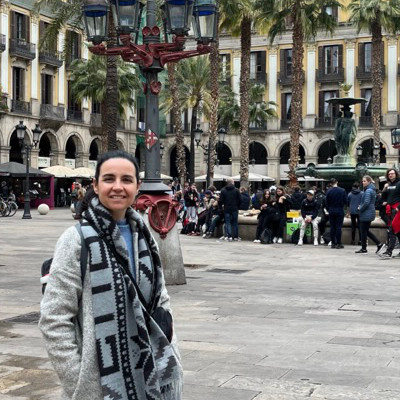Hospital de Sant Pau is often praised as Europe’s most significant art nouveau complex and one of the world’s most beautiful hospitals. It’s undoubtedly one of Barcelona’s most beautiful and representative attractions, embodying the city’s innovative spirit. Its real name, Hospital de la Santa Creu i Sant Pau, partly comes from a hospital that was previously located in the El Raval district, the Hospital de la Santa Creu.
What to See and Do at Recinte Modernista de Sant Pau
For lovers of architecture and Catalan Modernism, Hospital del Sant Pau is a must-see. During a visit to this former hospital, you can explore the complex and learn about its history.
The Façade of Hospital de Sant Pau
From the outside, Hospital de Sant Pau looks incredible. The monumental façade on Avinguda Gaudí completely breaks with the rectangular design of l’Eixample and offers us a fantastic view of the facade, richly adorned with sculptures, beautiful ironwork, stained glass windows, and palm trees.

The Old Hospital
The original design of the hospital included 48 pavilions and a main building intended for administration. All pavilions were connected by underground galleries, allowing patients to be transported without having to go outside. Outside, a garden was laid out where patients could get fresh air.
Another striking feature of the hospital was the strict separation between female and male patients. On the right side were the pavilions intended for men, named after male saints. On the left side were the pavilions for women, named after female saints and virgins.
Not all pavilions are open to the public, but a number are. Those that are open house exhibitions and photos from the past. From the outside, all pavilions look breathtakingly beautiful: a unique spectacle of applied art, with beautiful sculptures, mosaics, and stained glass windows.

Particularly impressive is the main building, where the administration was located. The beautiful halls, richly decorated with wood, mosaics, and stained glass, are a fine example of Catalan Modernism. The view from the first floor over the gardens and the pavilions on one side, and over Avinguda Gaudí and the Sagrada Família on the other, is also breathtaking.
The Hospital in the Evening
One of the most beautiful times of the day to see the hospital is when it gets dark. Then, the facade of the former hospital is illuminated. On special days (such as during Christmas), the façade is extra beautifully lit, with special themes, light installations, and projections.
Dining at 1902 Cafè Modernista
If you’re hungry after your visit, you can grab a bite at the bar-restaurant 1902 Cafè Modernista. A beautiful place to have a drink is on the terrace, with a view of the façade of the main building. Inside, the restaurant also preserves beautiful details like the original ceiling.
History of Hospital de Sant Pau
The origin of the Hospital de la Santa Creu i Sant Pau can be found in the old Hospital de la Santa Creu that was formerly located in the El Raval district. It was housed in a building that is now the Library of Catalonia, in the current Jardins de Rubió i Lluch, on Carrer de l’Hospital. Towards the end of the 19th century, the hospital became outdated and too small, necessitating a move. The result was an innovative modernist project, directed by Lluís Domènech i Montaner, in this part of l’Eixample. The name “Sant Pau” was later added to the name of the hospital as a thank you to the project’s sponsor, the Catalan banker Pau Gil i Serra.
Gil declared in his will that his estate should be used to build a new hospital in Barcelona. Among his instructions was that the new center must meet the most advanced innovations in technology, architecture, and medical perspective and that it be built under the patronage of Sant Pau. Thus, Hospital de la Santa Creu i Sant Pau was born, commonly known as “Hospital de Sant Pau.”

The ambitious project of Lluís Domènech i Montaner began in 1902 and lasted 28 years, with construction occasionally halted due to lack of resources and conflicts with the government.
When Domènech i Montaner died, the work was continued by his son Pere Domènech i Roura.
In 1930, the Hospital de la Santa Creu i Sant Pau was officially inaugurated by King Alfonso XIII.
It was a modern and spacious facility, consisting of separate pavilions surrounded by gardens and streets, resembling a small modernist city that took into account the patients and their quality of life.
After more than 80 years of service, the Hospital de Sant Pau moved in 2009 to its current location, a modern building on the northern side of the old hospital.
The old Hospital de Sant Pau is an important icon of Catalan Modernism and was declared a Historic Artistic Monument in 1978 and a UNESCO World Heritage Site in 1997.
Due to its architectural value and interest, the former hospital is now used as a cultural and tourist destination.
The monumental part of the Hospital de Sant Pau, with its entrance on Avinguda de Gaudí, has been beautifully restored since 2014 and is open to the public as a museum. Some of the old pavilions are now used as a knowledge campus and house the headquarters of international organizations.
Tickets for Recinte Modernista de Sant Pau
Recinte Modernista de Sant Pau or Sant Pau Recinte Modernista, the monumental part of the Hospital de Sant Pau, can be visited from the inside after purchasing entrance tickets or participating in a guided tour.
To visit the monumental part of the Hospital de Sant Pau, you need tickets, which can be bought online or on-site at the entrance. Tickets cost €16 per person, and you can choose to add an audio guide for an additional €4.
Children under 12 years old can enter for free, and other discount forms are available, such as the Barcelona Card, the Bus Turístic, or the Ruta del Modernisme.
Guided Tours of Sant Pau Recinte Modernista
You can also visit Sant Pau Recinte Modernista with a guide to learn all the ins and outs of this special hospital complex. It’s best to book tickets for these tours online in advance. Participating in a guided tour costs €20 per person (free for children under 12 years old). Languages: English and Spanish. Duration: 90 minutes.
How to Get to Hospital de Sant Pau
For the monumental part, it’s best to come via Avinguda Gaudí or take the metro to Sant Pau | Dos de Maig (L5). For the hospital itself, use the northern entrance, near Carrer de Sant Quintí and Carrer del Mas Casanovas. The closest metro stop is Guinardó | Hospital de Sant Pau (L4).
Useful information
Price: Normal €16 (€11.20 for visitors aged 12 to 29 and over 65). Children under 12 years old are admitted free. Discounts for Barcelona Card holders and hop-on-hop-off bus users.
Opening Hours: Daily from November to March from 10:00 AM to 4:30 PM (on Sundays from 10:00 AM to 2:30 PM).
From April to October from 10:00 AM to 6:30 PM (on Sundays from 10:00 AM to 2:30 PM).
Address: Carrer de Sant Antoni Maria Claret, 167 08025 Barcelona
Public Transport:
Metro: Sant Pau | Dos de Maig (L5), Guinardó | Hospital de Sant Pau (L4)
Bus: 19, 47, 117, 191, 192, D50, H8, N1, N0, N4, V23


